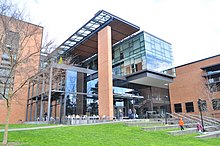University of Washington
The University of Washington, also known as Washington or UW (pronounced "U-Dub"), was founded in 1861.
Named for its location in Washington State, it is the largest university in the Pacific Northwest and one of the oldest institutions of higher learning on the U.S. West Coast.
The university consists of three parts: the largest campus in Seattle with 2.8 km² and two other higher learning institutions in Tacoma and Bothell. The university is a member of the Association of American Universities, an association of leading research-intensive North American universities that has existed since 1900.
It is one of the world's most research-intensive universities and is considered one of the best public universities in the United States, the so-called Public Ivy Universities. According to the U.S. News & World Report Global Ranking, the University of Washington ranks 10th among all universities worldwide and second among all public institutions in the United States. It ranks 16th in the world in Shanghai University's Academic Ranking of World Universities. The university excels particularly in medicine, computer science, and science and engineering. The faculties of Public Policy/Public Affairs, Health Sciences and Nonprofit Management are also among the best in the country. It is also one of the top-performing research universities in the world, ranked 5th by the U.S. National Science Foundation in terms of annual research expenditures.
It is also worth mentioning that the University of Washington, with a current endowment of 3.1 billion US dollars, is one of the richest universities in the world. It benefits financially and structurally from its historically grown proximity to the technology companies based in the Seattle metropolitan region, such as Microsoft, Amazon, Nintendo and Boeing. Graduates of the University of Washington make up the largest group of employees at the large IT and high-tech companies in Seattle, Silicon Valley and Silicon Forest, according to alma mater.
The university has produced many distinguished individuals in its history, including 20 Nobel Prize winners and numerous Pulitzer Prize and Fulbright Scholarship winners.
Forbes magazine named the 2.8-square-mile campus, with its more than 500 buildings, 26 libraries, green spaces and vistas, among the 15 most beautiful in the United States.

The Quad with Japanese Yoshino Cherry Trees

The Drumheller Fountain, built for the 1909 World's Fair, with Mount Rainer in the background.

Paccar Hall, home of the Foster School of Business.

Reading room of the Suzzallo Library built in 1926
History
The city of Seattle in the US state of Washington was one of the first settlements to be established in the newly founded Washington Territory between the mid and late 19th century. In 1854, Territorial Governor Isaac Stevens recommended the establishment of a university in Washington. Some prominent Seattle residents, led by Methodist preacher Daniel Bagley, saw the idea as a way to raise Seattle's prestige. They were able to convince Arthur A. Denny, co-founder and governing member of Washington Territory of the idea. They created a law that provided for two universities, one in Seattle and one in Lewis County. This was amended shortly thereafter, however, to provide for a university in Lewis County only, provided that land was donated locally.
However, when no land was found, Denny suggested in 1858 that the university be moved to Seattle. In 1861, a search began for a suitable piece (40,000 square feet) of land to serve as the university's campus. Denny, along with fellow pioneers Edward Lander and Charlie Terry, donated a piece of land at Denny's Knoll, an area that is now downtown Seattle. The area was located between what are now 4th and 6th Avenues, which border the area to the west and east, and between Union and Seneca Streets to the north and south.
On November 4, 1861, the university officially opened its doors. In the beginning, the university struggled with some problems and had to close three times: in 1863 for lack of students, in 1867 and in 1876 for lack of funds. By the time Washington joined the Union in 1889, however, Seattle and the university had grown substantially. While there were about 30 students enrolled at the beginning, there were now over 300. The growing student population required a new campus. A committee was therefore established to find a site for a new campus under the leadership of Edmond Meany - himself a graduate of the University. The committee chose a site in Union Bay northeast of the city center.
In 1895, the university was moved to the new site. The newly constructed building was named Denny Hall. In 1899, the predecessor building to the present Burke Museum was established on the campus. An attempt to sell the old campus failed. The area of the old campus is still owned by the university today and is called the Metropolitan Tract. It is located in the heart of the city and, as one of Seattle's most valuable real estate areas, brings in several million dollars in revenue each year.
Sports
The University of Washington's athletic teams are the Huskies. The university is a member of the Pacific-12 Conference. The college football team plays its games at Alaska Airlines Field at Husky Stadium. The men's and women's basketball teams, the women's volleyball team and the university's gymnastics team are based at Alaska Airlines Arena at Hec Edmundson Pavilion.
The Huskies' rowing team has produced numerous Olympians. Among them, the Huskies provided the eight that won at the 1936 Olympics.
·
Mascot Harry the Husky
· 
Alaska Airlines Field at Husky Stadium (2011)
·
Alaska Airlines Arena at Hec Edmundson Pavilion (2012)
Search within the encyclopedia

